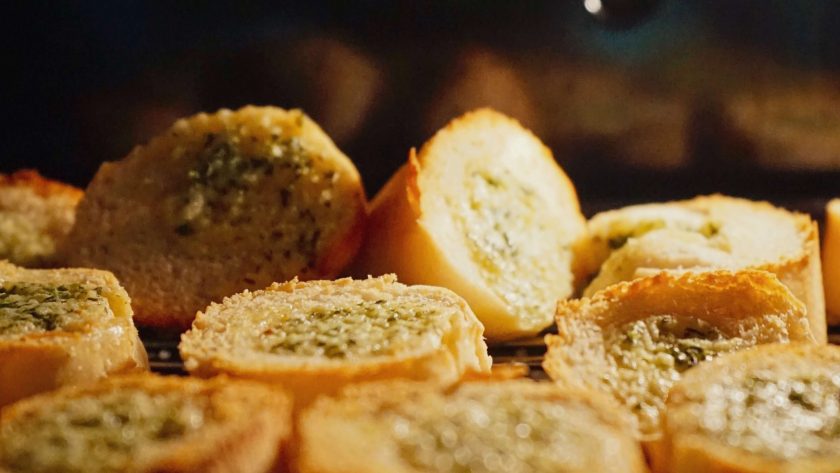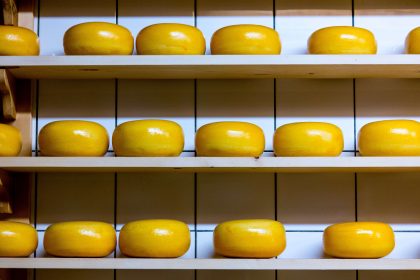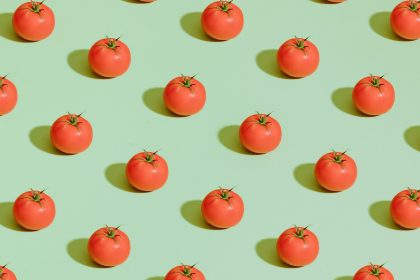Garlic bread is a popular side dish to accompany meals in many restaurants and homes. But have you ever wondered how many calories are in garlic bread? As a health-conscious food blogger, I’ve done some research to provide you with the answer.
The calorie content of garlic bread depends on several factors, including the type of bread, the amount of garlic butter used, and the size of the portion. On average, a serving of garlic bread that consists of one slice of French bread with garlic butter contains around 200-250 calories.
- Different Types of Garlic Bread: Which One is Best for Your Diet?
- Calculating the Calories in Basic Garlic Bread Recipe
- Low-Calorie Garlic Bread Varieties to Try Today
- Garlic Bread Dip and Spread: How Many Calories Are Hidden There?
- Garlic Bread in Restaurants: Calories and Serving Sizes
- The Health Benefits and Risks of Garlic Bread
However, some types of garlic bread can have significantly more calories due to added ingredients like cheese or oil. Therefore, it’s essential to be mindful of the specific garlic bread you’re consuming to accurately track your calorie intake.
Different Types of Garlic Bread: Which One is Best for Your Diet?
Garlic bread is a delicious addition to any meal, but it’s important to be mindful of its calorie content and choose the best option for your diet. Here we’ll discuss different types of garlic bread and their calorie counts to help you make an informed decision.
- Homemade Garlic Bread
Making garlic bread at home is a popular choice, as it allows you to control the amount of butter and oil used in the recipe. A typical homemade garlic bread recipe calls for a baguette, butter, garlic, and parsley. One slice of homemade garlic bread contains about 150-200 calories. To reduce the calorie count, you could use light butter and less oil.
- Garlic Knots
Garlic knots are another popular type of garlic bread, often served in pizzerias. They are small, twisted bread rolls brushed with garlic and butter. A serving of 3-4 garlic knots contains around 150-200 calories. Keep in mind that these small knots are easy to overindulge in, so be mindful of portion sizes.
- Garlic Breadsticks
Garlic breadsticks are a common side dish at Italian restaurants, but they can also be found in the frozen food section at your local grocery store. A single garlic breadstick contains around 100-150 calories. As with the other types of garlic bread, it’s important to watch portion sizes and consider the nutritional content of the rest of your meal.
- Cheesy Garlic Bread
Cheesy garlic bread is a popular variation of traditional garlic bread, as it adds melted cheese to the mix. However, this cheese can significantly increase the calorie count. One slice of cheesy garlic bread can contain around 250-300 calories, depending on the type and amount of cheese used.
If you’re watching your calorie intake, it’s important to be mindful of the type and portion size of garlic bread you consume.
Homemade garlic bread and garlic knots are good options, while cheesy garlic bread should be enjoyed in moderation. Remember, garlic bread is a delicious treat, but it shouldn’t be the main focus of your meal.
Calculating the Calories in Basic Garlic Bread Recipe
Garlic bread is a popular side dish that is typically made with bread, butter, and garlic. While it may be a delicious addition to any meal, many people wonder how many calories are in this tasty treat. In this section, I will break down the calories in a basic garlic bread recipe.
To calculate the calories in basic garlic bread recipe, we need to consider the ingredients used. Here’s an approximate breakdown of the calories in each ingredient:
- Bread: One slice of white bread contains an average of 79 calories.
- Butter: One tablespoon of butter contains around 102 calories.
- Garlic: One clove of garlic contains approximately 4 calories.
Assuming we use 2 slices of white bread, 2 tablespoons of butter, and 2 cloves of garlic, we can calculate the total calories in one serving of basic garlic bread recipe as follows:
- Bread: 79 calories/slice x 2 = 158 calories
- Butter: 102 calories/tbsp x 2 = 204 calories
- Garlic: 4 calories/clove x 2 = 8 calories
Total calories: 158 calories + 204 calories + 8 calories = 370 calories
It’s worth noting that the actual calorie count may vary based on the brands and exact amount of ingredients used. Additionally, adding cheese or other toppings may significantly increase the calorie count.
Serving of basic garlic bread recipe contains approximately 370 calories. By being aware of the calorie content of garlic bread, you can make informed decisions about how much and how often to incorporate it into your diet.
Low-Calorie Garlic Bread Varieties to Try Today
If you’re a garlic bread fan who is watching your calorie intake, there are a few recipe variations to consider that can help you enjoy this delicious side dish without overindulging in calories. Here are some low-calorie garlic bread varieties to try today:
Whole Wheat Garlic Bread
Whole wheat bread is a healthier alternative to white bread, and it makes for excellent garlic bread too. Instead of using regular white bread, use whole wheat bread, which is rich in fiber and contains more vitamins and minerals than white bread. You can also sprinkle less cheese or use low-fat cheese to further reduce the calories.
Garlic Bread with Olive Oil
Traditional garlic bread recipes call for butter, which can be replaced with olive oil. Olive oil provides a rich, buttery flavor and is much healthier than butter. In addition, olive oil is a good source of healthy fats and antioxidants, which makes this variation a great choice for those looking to watch their calories.
Low-Fat Garlic Bread
As an alternative to regular garlic bread, consider a low-fat version. One way to make low-fat garlic bread is to use fat-free sour cream, butter, or cream cheese. Replacing the regular ingredients with low-fat alternatives can help reduce the calorie count without sacrificing on taste.
Garlic Bread with Fresh Herbs
Adding fresh herbs to your garlic bread recipe is a great way to add flavor and reduce calories. Instead of using excessive amounts of cheese, try using a mixture of fresh herbs, olive oil, and garlic to add taste and health benefits.
Watching your calorie intake doesn’t mean you have to give up your garlic bread completely. By trying out some of these low-calorie variations, you can still enjoy the tasty garlic bread while keeping your calorie intake in check.
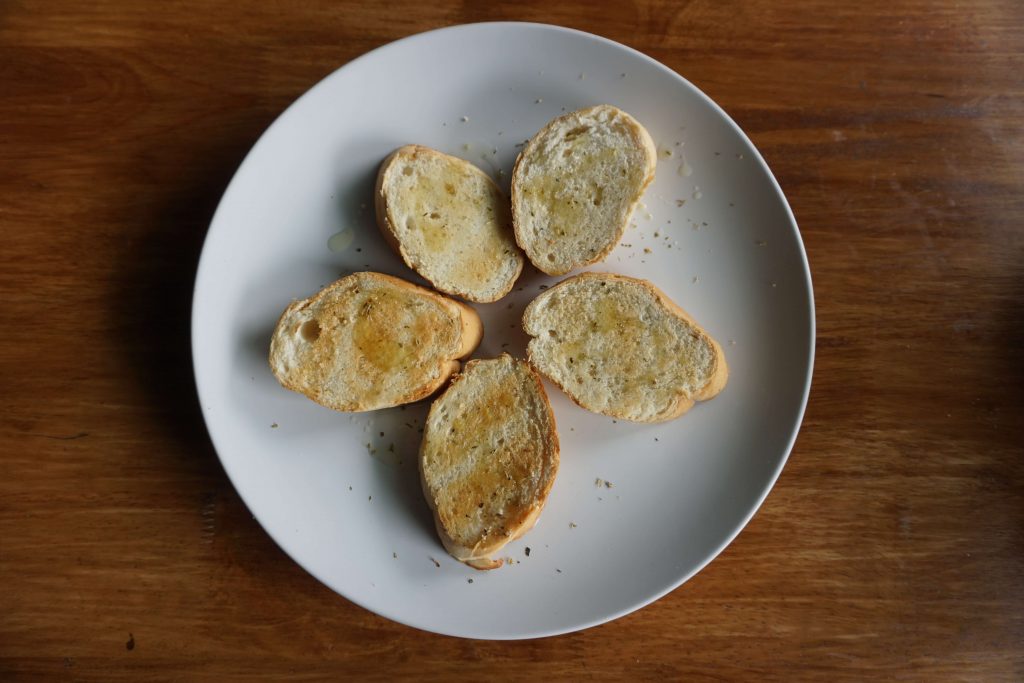
Garlic bread is a delicious and beloved dish that is often enjoyed as a side or appetizer. But many people are curious about the number of calories in garlic bread and its accompanying dips and spreads. In this section, we’ll take a closer look at just how many calories are hidden in these condiments.
Garlic Bread Dip and Spread: How Many Calories Are Hidden There?
Garlic bread is often accompanied by dips and spreads, which can add significant calories to an already calorie-dense food. Here is an overview of some popular garlic bread dips and their calorie content:
- Garlic Butter: Garlic butter is a popular and delicious dip for garlic bread, but it’s also high in calories. Just two tablespoons of garlic butter contain around 200 calories.
- Marinara Sauce: Marinara sauce is a classic dip for garlic bread, but it’s also relatively low in calories. A quarter cup of marinara sauce contains around 40 calories.
- Ranch Dressing: Ranch dressing is a common dip for garlic bread, but it’s also high in calories. Two tablespoons of ranch dressing contain around 145 calories.
- Alfredo Sauce: Alfredo sauce is a creamy and decadent dip that is often used for garlic bread, but it’s also very high in calories. Just a quarter cup of Alfredo sauce contains around 220 calories.
In addition to dips, garlic bread is often brushed with olive oil or butter, which can add extra calories. Here are some key facts about the number of calories in garlic bread:
- A typical slice of garlic bread contains around 120-150 calories.
- A serving of garlic bread (usually two slices) contains around 240-300 calories.
- Garlic bread made with white bread is typically higher in calories than garlic bread made with whole wheat or multigrain bread.
Garlic bread and its accompanying dips can contain a significant number of calories. If you’re watching your calorie intake, it’s important to enjoy garlic bread and its dips in moderation.
Garlic Bread in Restaurants: Calories and Serving Sizes
Well, calories and serving sizes can vary greatly depending on the establishment. Let’s take a look at a few examples to get an idea of what you might be consuming.
Example 1: Olive Garden
At Olive Garden, a serving of their garlic breadsticks (which come with unlimited refills) is considered to be two pieces. Each serving contains 140 calories, 2 grams of fat, and 460 milligrams of sodium. While this may not seem too bad on its own, it’s important to keep in mind that most people don’t stop at just one serving.
Example 2: Red Lobster
Red Lobster’s garlic cheddar biscuits are a fan favorite, but they’re definitely not for the calorie-conscious. Each biscuit contains around 150 calories and 10 grams of fat. And just like Olive Garden’s breadsticks, it’s easy to lose track of how many you’ve eaten when they keep bringing more to the table.
Example 3: Carrabba’s Italian Grill
Carrabba’s garlic bread is served as a starter before your meal. According to their nutrition information, two slices of their bread contain 240 calories, 10 grams of fat, and 540 milligrams of sodium. While it may be tempting to indulge in a few extra slices, remember that they can add up quickly.
Comparison Table
To give you a better idea of how these restaurant options compare, here’s a table summarizing the calorie and fat content for each:
| Restaurant | Serving Size | Calories | Fat (g) |
|---|---|---|---|
| Olive Garden | 2 breadsticks | 140 | 2 |
| Red Lobster | 1 biscuit | 150 | 10 |
| Carrabba’s | 2 slices | 240 | 10 |
It’s important to make informed decisions when dining out, especially when it comes to indulgent appetizers like garlic bread. While these options may be delicious, they can quickly contribute to a high calorie and fat intake for the day.
The Health Benefits and Risks of Garlic Bread
Garlic bread is a beloved side dish that can be enjoyed as part of a meal or as a snack on its own. While garlic bread is typically high in calories due to the bread and butter used, it does have some potential health benefits to keep in mind:
Health Benefits
- Garlic is known for its potential immune-boosting properties. Garlic has been found to have antimicrobial, antiviral, and antifungal properties that may help strengthen the immune system and fight infections.
- Similarly, garlic may contribute to heart health by helping to lower blood pressure and reduce cholesterol levels.
- Garlic also contains antioxidants that can help protect the body against damage from free radicals.
- Some studies suggest that consuming garlic may have cancer-fighting properties as well.
Health Risks
- Garlic can cause digestive issues for some people, including bloating, gas, and diarrhea.
- Individuals taking blood-thinning medication should consult with a medical professional before consuming garlic regularly, as it can increase the risk of bleeding.
- Additionally, garlic may cause bad breath and body odor due to its strong scent.
While garlic bread may have the potential for some health benefits, it is important to consume in moderation due to its high calorie and fat content. If you are trying to watch your weight or fat intake, it may be best to limit your consumption of garlic bread or opt for a healthier alternative. However, for those who don’t have a specific calorie or fat restriction, garlic bread can be a delicious and enjoyable treat to indulge in occasionally.
By indulging in garlic bread, it’s easy to forget about the caloric consequences. A typical serving of garlic bread can range anywhere from 150 to 500 calories, depending on the portion size and ingredients used. In order to balance out the calorie intake, incorporating exercise into your routine is key.
Here are some tips on how to balance your garlic bread consumption with exercise:
Opt for Lean Protein and Vegetables
When ordering garlic bread as a side dish, try to make healthier choices for your main course. Opt for lean protein, such as chicken or fish, and pair it with a side of vegetables. This will help balance out the calorie intake from the garlic bread and provide your body with essential nutrients.
Incorporate Cardiovascular Exercise
Cardiovascular exercise is a great way to burn off calories and improve your overall fitness. Consider incorporating activities such as jogging, cycling, or swimming into your routine. These exercises can help burn off the calories from the garlic bread and improve your heart health.
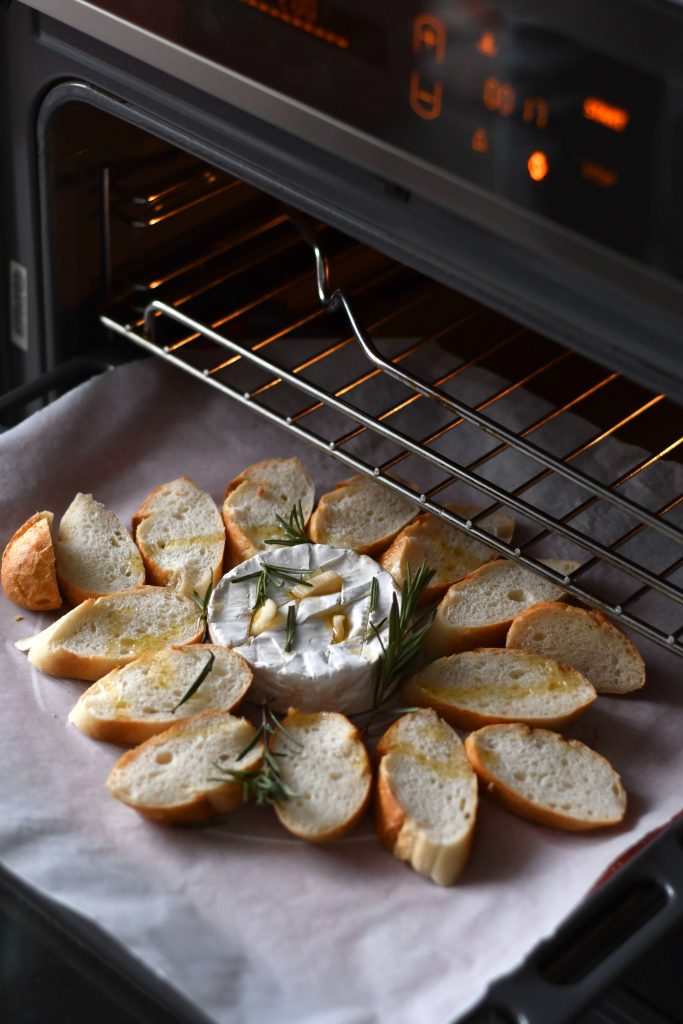
Engage in Strength Training
In addition to cardiovascular exercise, strength training is also important for maintaining a healthy balance between calorie intake and exercise. Strength training helps build muscle mass, which in turn can increase your metabolism and help burn off excess calories.
Stay Consistent
The key to balancing your garlic bread consumption with exercise is consistency. Make sure to engage in at least 30 minutes of exercise per day, and monitor your calorie intake. By staying consistent with your healthy habits, you can indulge in garlic bread without guilt or worry.
It’s important to remember that balance is key. Enjoying garlic bread in moderation and pairing it with a healthy diet and regular exercise can help you maintain a healthy lifestyle.
Tips and Tricks for Making Healthy Garlic Bread at Home
Garlic bread is a popular side dish that goes well with a variety of meals, from spaghetti to steaks. However, the traditional version is often high in calories, fat, and sodium. Fortunately, with a few tweaks, you can make a healthier version of garlic bread that is just as delicious and satisfying. Here are some tips and tricks to help you get started:
- Choose whole-grain bread: Whole-grain bread is a great source of fiber and nutrients, which can help you feel fuller for longer. It also has a lower glycemic index than white bread, which means it can help regulate your blood sugar levels and prevent overeating.
- Use olive oil instead of butter: Olive oil is a healthier fat than butter, as it contains more unsaturated fats and less saturated fat. It also has anti-inflammatory properties that can help reduce your risk of chronic diseases.
- Use fresh garlic: Fresh garlic not only tastes better than garlic powder, but it also contains more beneficial compounds, such as allicin and sulfur. These compounds have antimicrobial and anti-inflammatory properties that can boost your immune system and reduce inflammation in the body.
- Add herbs and spices: Instead of relying on salt for flavor, try adding herbs and spices to your garlic bread, such as parsley, basil, oregano, or red pepper flakes. These seasonings not only add flavor but also provide a variety of health benefits.
- Watch your portions: Garlic bread can be a high-calorie food if you eat too much of it. To keep your portions in check, try slicing the bread into smaller pieces or serving it with a side salad or vegetables.
By following these tips and tricks, you can enjoy a healthier version of garlic bread that is both delicious and good for you. Below is a summary of the tips and their benefits:
| Tip | Benefit |
|---|---|
| Choose whole-grain bread | Provides fiber and nutrients, helps regulate blood sugar |
| Use olive oil instead of butter | Contains healthy unsaturated fats and anti-inflammatory properties |
| Use fresh garlic | Contains beneficial compounds with antimicrobial and anti-inflammatory properties |
| Add herbs and spices | Provides flavor and various health benefits |
| Watch your portions | Helps control calorie intake |
For those of us who are watching our calorie intake, garlic bread may not always be the best option. But fear not, there are alternatives that can satisfy your craving for bread without packing on the calories. Here are some options to consider:
Whole Wheat Bread
If you’re craving bread with a little more substance, whole wheat bread is the answer. Not only is it higher in fiber, which helps you feel full, but it also has fewer calories than other types of bread. So, not only will it satisfy your craving for bread, but it will also help you stay on track with your diet.
Pita Bread
Pita bread is a great alternative to garlic bread because it’s lighter and lower in calories. It also has a unique texture that can provide a satisfying crunch. Try it toasted with some hummus or other low-calorie dips for a healthy snack or appetizer.
Garlic Bread with Low-Calorie Ingredients
If you can’t live without garlic bread, there are ways to make it a little healthier. Swap out regular bread for whole wheat bread and use olive oil instead of butter. You can also use garlic powder instead of garlic salt to cut down on sodium.
Cauliflower Bread
Cauliflower bread is a great option for those on a low-carb or gluten-free diet. It’s made with cauliflower rice and eggs, and can be seasoned with garlic and other herbs for a tasty alternative to traditional bread.
Zucchini Bread
Zucchini bread is another great option for those watching their calorie intake. It’s made with grated zucchini, which makes it both moist and low in calories. You can also add garlic and other herbs to give it a savory flavor.
So, there are plenty of alternatives to garlic bread for those who are looking to cut back on calories.
Whether you opt for whole wheat bread, pita bread, or a low-calorie version of garlic bread, you can still enjoy the taste of bread without compromising your diet.

